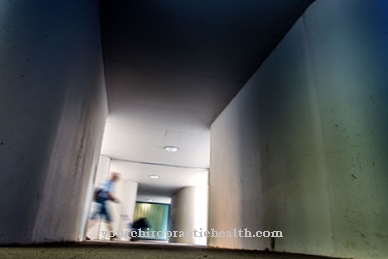A Fibroma is a benign, mostly discolored tumor in human skin or connective tissue. In most cases it is quite harmless and can be eliminated if it is bothersome, painful or displeasing for cosmetic reasons. The fibroma is quite common overall.
What is a fibroma?

© Ella - stock.adobe.com
A fibroma usually describes a benign and tumor-like growth in human skin tissue or in connective tissue. The way in which this adhesion manifests itself is determined by the occurrence of uncontrolled cell growths, similar to those of a tumor.
A fibroma is not as malignant as cancer, so it is basically harmless. Nevertheless, the skin growth can cause discomfort and complications that can reduce the quality of life of the person concerned.
causes
The causes of fibroids are difficult to determine in most cases, but sometimes they are due to injury. They can appear all over the body, but surgery is rarely required.
It can affect both men and women, as well as all age groups. Most often, however, the fibroma occurs in an adult person. Research now assumes that fibroids are caused by injuries to the skin tissue. However, genetic reasons are also suspected, which mainly occur in Northern Europe.
There are also certain drugs, such as beta blockers, that have an unfavorable effect on the skin tissue and thus promote the development of fibroids. Risk factors are to be looked for mainly in the family environment when fibroids occur more frequently here.
You can find your medication here
➔ Medicines against redness and eczemaSymptoms, ailments & signs
Fibromas appear as protrusions of the skin and represent benign tumors. They can be both hard and soft and also appear as so-called irritable fibromas on the oral mucosa. Soft fibromas are observed especially in the armpits, neck, groin, or under the breasts.
They are often stalked and have small wrinkles on the surface. They are the same color as the skin. However, they turn red to black due to damage to small blood vessels when rotated. The soft fibromas are located in the area of the skin and are visible from the outside.
In contrast, hard fibromas can be both raised and sunken in relation to the surface of the skin. Their coloring is a little darker and sometimes gray-brownish. The Fitzpatrick sign is typical of a hard fibroma. The Fitzpatrick sign is characterized by the fact that the fibroma sinks into the skin when the surrounding area is squeezed with the thumb and forefinger.
Black moles and hard fibromas are often confusingly similar. However, they can be distinguished by the Fitzpatrick sign. Black moles do not sink into the skin when you squeeze the outer area. The so-called irritable fibroma is located on the oral mucosa. These are small bumps that sit either in the area of the cheeks, on the edge of the tongue or on the gums. All fibroids are painless and benign.
Diagnosis & course
If the doctor suspects a fibroma, the following procedures are used to make a diagnosis. These include CT, X-ray examinations, MRI, biopsy or endoscopy. A tissue biopsy is most effective because it gives the doctor the opportunity to analyze the affected areas directly.
To do this, tissue is removed and examined in the laboratory. Then the doctor can see whether there is actually a fibroma or whether it is a malignant tumor. Unfortunately, medical errors are becoming more common and cancer is mistaken for a harmless fibroma, or vice versa. The latter then leads to unnecessary therapies that burden the patient, or an existing tumor is treated too late.
Small skin growths are symptomatic of a fibroma. It can also cause discoloration and skin irritation when touched. The fibroma can also be easily injured, and then it bleeds profusely. Fibromas usually form on the feet in the form of nodules on the instep. This can also cause pain caused by pressure. Here the symptoms range from discolouration and itching to clearly visible bumps on the skin, which increase in size over time.
Usually, however, a fibroma is harmless and does not require treatment. Sometimes, however, it grows so excessive that an operation has to be performed, especially if the fibroids cause discomfort or severely restrict the person affected.
Complications
As a rule, there are no further compilations or complaints with a fibroma. The fibroma itself is a harmless symptom, but it can be removed if it bothers the patient and causes pain. The fibroma causes tumors and growths in the affected person.
Itching can also spread on these and the skin areas are reddened. In any case, the patient should not scratch the areas, otherwise wounds or scars may occur there. In some cases, people feel ashamed of the fibroma and feel unattractive. Self-esteem drops, which can lead to mental health problems or depression.
There is often irritation or discoloration on the affected areas. Pain rarely occurs, mainly pressure pain, so the fibroma does not hurt without touch. There are no other health complications with a fibroma.
If it is very annoying for the patient, the fibroma can be removed by surgery. There are no further complaints and the affected area heals again after a short time.
When should you go to the doctor?
A doctor should be consulted as soon as there are unusual changes in the complexion of the skin. If you notice swellings, growths or lump formation in the skin, they should be examined and, if necessary, treated. If there is any discomfort, pressure or numbness on the skin, it is advisable for a doctor to examine the symptoms.
A medical examination is necessary as soon as the changes cause pain. Before using cosmetic products that aim to beautify the affected skin, you should consult a doctor.
If there is a feeling of tightness, a general feeling of illness or itching, a doctor's visit is necessary. If open wounds occur, germs can enter the organism and trigger further diseases. A doctor should therefore be consulted as soon as the first irregularities occur in wound healing or there is no adequate possibility of sterile wound care.
Discoloration of the skin, persistent general malaise or inner restlessness should also be clarified. If the visual changes lead to emotional or psychological problems, a doctor should be asked for advice and help. With behavior change or social withdrawal, there is cause for concern that should be addressed. From middle age onwards, regular check-ups by a dermatologist are also advisable.
Doctors & therapists in your area
Treatment & Therapy
A fibroma of the skin tissue is usually completely harmless and does not require any further therapy. If there are still symptoms or if it proves to be otherwise complicated, the patient has the option of having the fibroma surgically removed.
These skin changes that occur on the feet are very difficult to remove and require longer therapy. The consequences of the operation can be very serious. For this reason, an alternative therapy is usually recommended. Here, for example, cryotherapy can be used or the wearing of special insoles. In the case of an operation on the foot, the healing process is slow and the risk of further complications increases enormously.
If the invasive procedure cannot be avoided, the following methods are available: the injection of corticosteroids, the surgical removal of the entire tendon plate of the foot, or the removal of the pure fibroid. All of these treatment methods usually do not have great risks, but they can sometimes lead to unpleasant side effects.
Outlook & forecast
A fibroma has a favorable prognosis. Since the tissue changes and growths are harmless from a medical point of view, there is no reason for a health hazard. It is an optical flaw that does not require any treatment from a medical point of view. With a fibroma, no consequential physical damage or impairment of mobility is to be expected.
Regardless of the outlook described, the well-being of the person affected can still be reduced and mental problems can occur. In order to avoid the development of serious mental disorders, supportive therapy can be used. The prognostic perspective of psychological treatment is individual and is directly related to the relationship of trust with the therapist and one's own cooperation during the therapy.
In addition, if desired, surgical intervention can help relieve the existing symptoms. This is a routine treatment that is usually carried out without further complications and is of short duration.
Despite the generally good prognosis, a new fibroma can develop at any time in the course of life. This risk also exists in patients who have undergone surgery. The new growth of the connective tissue and the spread of the complaints do not lead to any change in the favorable outlook.
You can find your medication here
➔ Medicines against redness and eczemaprevention
The causes for the development of a fibroma are very difficult to determine. Many circumstances suggest that genetic factors play a crucial role. Thus, it is very difficult to prevent the fibroma appropriately.
Such skin changes, which are in the area of the mouth, lips and cheek, are mostly caused by various injuries. It is therefore important to avoid chewing on your cheeks and lips. Adequate hygiene can also counteract the formation of a fibroma. The genetic causes cannot be influenced.
Aftercare
In the case of a fibroma, those affected have only limited measures or options for follow-up care. First and foremost, the disease should be recognized and treated very early so that there are no compilations and also no tumor formation. For this reason, early diagnosis with subsequent treatment is the main focus of the disease. Removal is not always necessary.
However, if there are aesthetic problems, the fibroma can usually be removed relatively easily. The affected person is dependent on an uncomplicated surgical procedure. After this procedure, the person affected should rest and take care of their body. Exhausting or stressful activities should not be carried out. The affected area in particular should be particularly protected.
After the procedure, regular examinations by a doctor are very useful in order to identify further symptoms. Since the fibroma also leads to aesthetic restrictions, measures of psychotic treatment are also necessary in some cases. Conversations with friends or family can also be very helpful. The fibroma does not usually reduce the life expectancy of the person affected.
You can do that yourself
The removal of soft fibroids is often not necessary because they are benign tumors. There is no health risk and the person concerned can live with them. However, they often interfere with the aesthetic perception of the person affected, depending on where these fibroids occur on the body.
Soft fibromas can be easily removed with a home remedy. This remedy is apple cider vinegar, which is already present in most households. Fibromas anywhere on the body except those that appear on the face can be treated with apple cider vinegar. Fibromas on the face should be treated directly by a doctor.
The apple cider vinegar is gently applied to the fibroids by the person concerned with a piece of cotton wool. This process is best repeated three times a day for about two weeks until a change in the fibroids is visible. There is a change in the color of the fibroids. They turn dark and dry out. Then they detach themselves from the affected person's skin.
If the apple cider vinegar does not have the desired effect, a doctor should be consulted. In the case of pedunculated and smaller fibromas, these can also be removed by the person concerned with sterile tweezers. However, this does not apply to large-area fibromas.

.jpg)

.jpg)

.jpg)


















.jpg)



